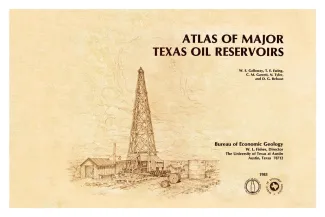
Publication Details
Geolocation:
Get the Publication
$50.00
Abstract/Description:
The search for oil, its development, production, and marketing have, for the better part of a century, been a fundamental part of the Texas economy. The history of Texas oil finders, from the self-educated wildcatter to the highly trained explorationist, is a part of Texas lore.
Since the first oil well in Texas was completed near Nacogdoches in 1866, Texas operators have drilled some 650,000 wells in search for oil, or about 3 percent of all the oil wells drilled in the world. That effort has resulted in the discovery of 156 billion barrels of oil in about 34,000 different reservoirs, ranging from the 9.4 billion barrels in the Spraberry trend and the 7.6 billion barrels in East Texas (Woodbine) to reservoirs that are only marginally commercial at $40 per barrel.
About 70 percent of Texas oil found to date has been discovered in some 500 major reservoirs. These major reservoirs, each of which will produce more than 10 million barrels of oil, are the subject of this Atlas of Major Texas Oil Reservoirs. The Atlas summarizes the principal geologic and production characteristics of the major reservoirs and classifies the reservoirs into 48 regional plays. It is a synthesis of the diverse range of conditions under which Texas oil accumulated. The information will be useful in the eventual discovery of additional oil reservoirs in the state.
But the Atlas is, as it should be, more than a catalog of past discoveries and production. Of the 156 billion barrels of oil discovered in Texas so far, less than 35 percent, or some 54 billion barrels, will be recovered by conventional means. Of that conventionally recoverable volume, 85 percent has already been produced. No one knows how much oil in Texas is yet to be discovered; estimates vary by an order of magnitude. But we do know that the volume of oil being discovered in recent years is relatively small—an expression of exploratory maturity in the Texas oil basin. The future of Texas oil production depends on success in recovering part of the more than 100 billion barrels known to be in the ground, but not recoverable with conventional technologies. The systematic analysis of the major reservoirs in this Atlas is designed to enlarge our knowledge of existing reservoirs and thus aid additional recovery efforts.
The Atlas of Major Texas Oil Reservoirs is issued by the Bureau of Economic Geology as a Centennial publication of The University of Texas at Austin in recognition of the importance of oil to Texas and this University.